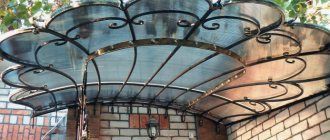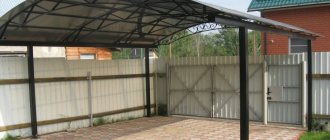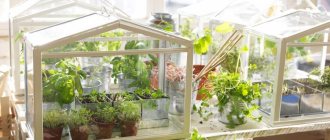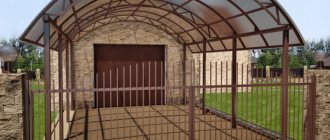Polycarbonate is one of the most practical and beautiful modern materials for construction. It is relatively new, because... appeared only a couple of decades ago. Polycarbonate is not only reliable and has excellent strength, but also transforms the entire landscape design with its presence on garden buildings! Experts say that such transparent panels give the surrounding space an element of airiness and lightness.
Polycarbonate canopies for a summer house or country house are especially beautiful. If you have chosen just such a coating, then study the technology of its installation with us!
Rules for the use of raw materials
There are rules for handling polycarbonate sheets established by experience:
- You should not store the material in the light; you should consider the way they are stored in the warehouse;
- the material should not crack from twisting;
- The protective film can be removed only after finishing work with the sheets;
- work on installing the flooring should be carried out quickly;
- The slabs must be laid with the UV-resistant side facing outwards, as indicated on the surface of the protective film.
Leaving cellular polycarbonate in the film in the open light will cause it to stick tightly to the plate, that is, a photochemical reaction, causing the material to become unusable.
Briefly about the main thing
You can build and assemble a canopy or terrace in just a few days, thanks to quick installation. Does not require labor-intensive care.
Plastic is selected based on the structural features of the canopy and technical load. Depending on the color of the polycarbonate, light transmission changes, which must also be taken into account.
Polycarbonate is a beautiful, lightweight, light-transmitting material. The variety of types and technical characteristics make it possible to select it for different types of structures.
Ratings 0
Advantages and nuances of construction
The photo of polycarbonate canopies shows universal outdoor structures that perfectly transmit natural light and have a wide range of colors.
The raw material is quite light, transparent and has a variety of convenient thickness formats, this helps to create any type of structure: from simple to curved parts. In addition, they easily and harmoniously fit into any interior and landscape of a personal plot.
Polycarbonate canopies are divided into the following types:
- separate, self-standing ones are most often acceptable for swimming pools, gazebos, greenhouses, carports in parking lots and over outbuildings;
- the mobile type quickly moves to any selected point of the perimeter: barbecue roof, compact gazebo;
- as an extension to a garage, bathhouse, veranda, porch canopy.
These structures can be rectangular, curved, or two-story. They are also divided into open and closed models, for which the walls on the sides are usually covered with glass, gratings, lining, or thick textiles.
The building includes pillars for vertical support and the roof itself. To make frames, wood, metal beams, concrete, brick, and stone are used.
Components, installation features
Before deciding what thickness of polycarbonate to choose for the canopy, you need to make a project and calculate the materials based on it. It is better to use the services of professional builders. You can use online calculators for these purposes.
The calculator will help you calculate the approximate number of polycarbonate sheets Source polycarbonat-rostov.ru
Any structure consists of a supporting structure and a polycarbonate coating.
The supporting structure includes supports and a frame for attaching polycarbonate. Made from metal, aluminum profiles, wooden beams. Regulated by regulatory construction acts and SNiP rules (2-523-81 for steel structures; 3.04.03-85 – corrosion protection).
The main components are made of polycarbonate and aluminum profiles.
Details for installing polycarbonate:
- profile: end, connecting, adjacent, corner, ridge, clamping strips.
- thermal washers with silicone gasket;
- seals, end tapes.
End profile Source baumaster69.ru
Polycarbonate expands as a result of temperature fluctuations. Due to the high coefficient of thermal expansion, a gap of 3-3.5 mm is made between the sheets of material. The hole for the fastening is drilled a few millimeters larger.
The standard length of cellular plastic sheets is 6 and 12 m, width 2.1 m. Profiles are produced in accordance with the size of polycarbonate - 6 m.
Installation diagram Source sadov0d.ru
Types of profiles:
- Connecting profiles in the shape of the letter “H” are one-piece, detachable from 2 parts of the base and cover. The base is screwed to the longitudinal guide bars of the frame. The roof snaps or screws onto the base.
- Adjacent in the shape of the letter "F". Installed in places adjacent to the wall. Attached with self-tapping screws or sealant.
- The corners are connected with a special profile made of plastic or aluminum. They produce corner profiles with different degrees of slope.
- If the roof shape has slopes, a ridge profile is installed at the joint junctions.
- The end plate in the shape of the letter “P” acts as a plug. It is installed along the edge with an indentation, a hole is made in it so that the moisture accumulated inside the honeycomb flows to the ground. Before installing the plank, end tape is glued to the end, preferably with perforated holes.
- Pressure profile or strip. They are usually made from aluminum. Additionally, the sheet is fixed.
Components for polycarbonate Source rs36.rf
Wooden canopy
The easiest to install and relatively cheap way to create a universal street roof is a polycarbonate canopy with a wooden support.
This work does not require professional equipment or special skills at all; an ordinary set of tools, which almost any owner has, will do.
You will need glued and profiled timber, rounded logs, and wooden posts. To build a rafter system, you will need edged boards.
Please note that the design has quite significant disadvantages:
- does not retain moisture well;
- susceptible to rotting and fungal diseases;
- quickly loses strength, reliability and aesthetic appearance, which leads to product failure.
To avoid these factors, it is recommended to treat the canopy and canopy with a fire-resistant composition, antiseptics and protective layers of oil and varnish.
Selection of quality material
How to choose polycarbonate for a canopy, what you need to pay attention to.
The sheet is covered on both sides with self-adhesive film. The back side, which is attached to the frame, is transparent. On the outside - colored, with the company logo, markings, indicating the thickness of the protective layer. Before installation, only the bottom transparent film is removed. With an indentation of 10 cm around the perimeter of the sheet, wrap the film with the logo. This is necessary so that it does not interfere with installation work. It is finally removed after installing all the sheets. This sequence eliminates the possibility of confusion between sides with and without UV protection.
The outer side of the sheet with the logo Source profistroy-ekb.ru
Types of application of a UV protective layer:
- Spraying. Not a very reliable method. Under the influence of mechanical, snow load, it collapses over time, approximately 3-4 microns per year. Accordingly, the service life is reduced.
- By extrusion method. It is applied immediately to plastic that has not yet cooled down, soldered to the surface, a more reliable coating.
- Adding a special stabilizer to the mass of granules (up to 30% of the total mass). This protection makes the material resistant to UV radiation and is guaranteed to last 10-15 years or more. But the cost also increases.
The second important point is the density of the material. According to existing standards, for a certain type of polycarbonate, its thickness corresponds to the weight of the sheet. Sometimes, manufacturers of low-quality plastic ignore these recommendations in order to reduce costs. The layers and stiffening ribs of the honeycomb are made thinner. When squeezed with your fingers, the honeycombs collapse. When a piece of material is bent, a characteristic crack is heard, and microcracks may appear. High-quality polycarbonate is difficult to press with your fingers; it bends quite hard. When installed on an arched structure, it acquires additional strength due to the internal pressure of the sheet.
Metal construction
Before making a metal canopy in the yard, you need to take into account the following parameters of the structure:
- A forged base will be the most elegant and attractive, but it will require significant expenses. If funds allow, it is better to make an exclusive product to order.
- The most common and relevant building is a canopy made of round or profile pipes. The size of the pipe directly depends on the size of the building.
- Prefabricated finished model made of aluminum.
The main advantage of an iron canopy is its durability, but despite this fact, it is easily susceptible to corrosion.
To avoid such a nuisance, it is recommended to first clean the product with a stiff brush from possible rusting and scale, then treat the entire surface with abrasive and wipe with a solvent. The next step is coating with primer or paint.
Please note that the railings of a porch or gazebo should be made of wood, since metal quickly heats up from the sun and cools down from frost!
- Lawn laying
A garage at the dacha is not a warehouse, but a modern and comfortable space!
Diesel generator for home: which one to choose?
Pros of polycarbonate
This building material has many unique qualities that make it almost irreplaceable in many cases. This:
- Sufficient light transmission (transparency), reaching up to 85% (depending on the color and thickness of the sheet);
- It is lightweight, for example, when compared with glass, its weight is about 7-8 times less;
- Good flexibility of the canvas even without preliminary preparatory work;
- Evenly diffuses light;
- Excellent resistance to impacts and damage, the ability to withstand the load of gusts of wind, the severity of snow;
- Good heat and sound insulation properties;
- Special protection protects against chemical or UV exposure;
- Affordable for almost any family;
- Modern aesthetic appearance of buildings;
- Harmless to humans;
- Ability to withstand a wide temperature range - from −50 to +115 degrees;
- A high-quality product with a protective coating will reliably serve its owners for up to 20-25 years.
Its main advantage when building a canopy with your own hands is the ease of installation, even without assistants and in short periods of time.
Stone and brick as a base
All types of polycarbonate roofing with a stone, brick and concrete base look very luxurious, rich, but at the same time do not lose their lightness, which is ensured by a transparent canopy. Such supports are easy to maintain, resistant to fire, cope well with natural precipitation and are resistant to mechanical damage.
However, their installation will require significantly more time, effort and financial costs. Moreover, this building is being built for a long time, since it cannot be dismantled, that is, moved to another place on the territory.
Bungalow
For exotic lovers, you can use thick hewn branches for the structure; the covering can be made of reed mats or sheaves.
If you do not achieve complete tightness, do not worry, digging is not dangerous for such a structure. But in terms of price, such a structure is super profitable, and the material is easily available.
Creating a Project
When choosing a design project, it is worth deciding on the following parameters:
- dimensions and purpose of the structure;
- plot size;
- snow and wind loads;
- snow depth and expected annual precipitation;
- structural features of the main structure.
A pre-created project allows you to choose the best solution and select high-quality material
Before installation work, a drawing must be completed. Based on the size of the building, the required amount of material is determined.
Preparatory work
Before the planned sheds attached to the house are created, photos of which can be viewed on the website, it is necessary to carry out preparatory work. For this purpose, a suitable area is marked out, and trees are uprooted from it. The clean area is leveled. At the same time, sand and gravel are added.
Some durable sheds require a foundation
Recesses are drilled under the canopy supports. And at this stage it is worth considering laying the cable under the lighting sources. A certain step for placing supports is selected. It depends on the weight of the roof and frame part.
The number and placement of racks must be calculated in advance
The stands are lowered into the prepared pits and filled with concrete mixture. The pillars are set according to level.
Let's sum it up
Polycarbonate is a material that has revolutionized the construction of transparent roofs. This is the only real alternative to glass not only for small buildings, but also for critical objects. Polycarbonate comes in three types:
- Monolithic is the most durable, even bulletproof, and durable, but expensive, heavy and difficult to install.
- Profiled - lightweight, very easy to install and quite durable, but it withstands impacts less well and practically does not prevent heat loss.
- Cellular is extremely cheap, very light and can withstand light impacts well, but transmits less light, is a short-lived and often unaesthetic material.
Polycarbonate is mainly used to make flat, single-pitched, gable and arched roofs of gazebos, terraces, galleries, verandas, greenhouses, and canopies.
To install monolithic polycarbonate, it is better to hire specialists, while profiled and honeycomb sheets can be installed on the roof yourself. How is written in detailed instructions in this article.











